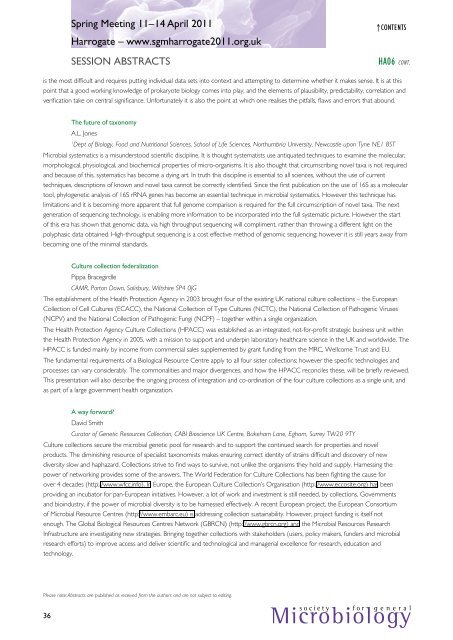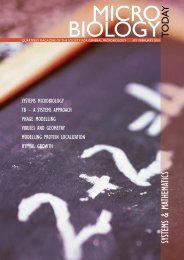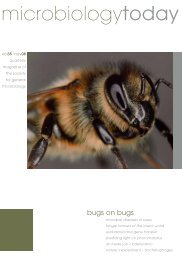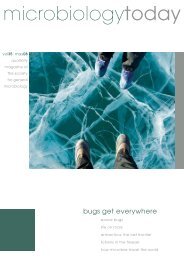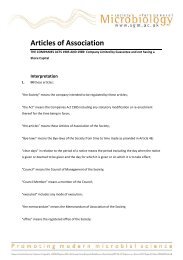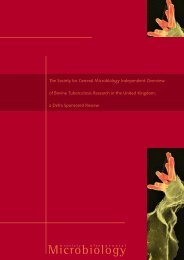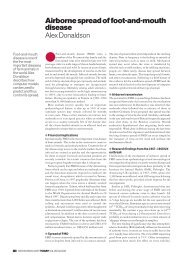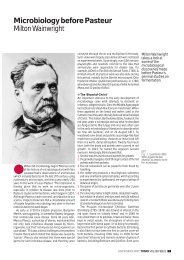Spring Conference 2011 - Society for General Microbiology
Spring Conference 2011 - Society for General Microbiology
Spring Conference 2011 - Society for General Microbiology
Create successful ePaper yourself
Turn your PDF publications into a flip-book with our unique Google optimized e-Paper software.
Please note: Abstracts are published as received from the authors and are not subject to editing.<br />
36<br />
<strong>Spring</strong> Meeting 11–14 April <strong>2011</strong><br />
Harrogate – www.sgmharrogate<strong>2011</strong>.org.uk<br />
SESSION AbSTrACTS<br />
↑Contents<br />
HA06 Cont.<br />
is the most difficult and requires putting individual data sets into context and attempting to determine whether it makes sense. it is at this<br />
point that a good working knowledge of prokaryote biology comes into play, and the elements of plausibility, predictability, correlation and<br />
verification take on central significance. un<strong>for</strong>tunately it is also the point at which one realises the pitfalls, flaws and errors that abound.<br />
The future of taxonomy<br />
A.l. Jones<br />
1Dept of Biology, Food and Nutritional Sciences, School of Life Sciences, Northumbria University, Newcastle upon Tyne NE1 8ST<br />
Microbial systematics is a misunderstood scientific discipline. it is thought systematists use antiquated techniques to examine the molecular,<br />
morphological, physiological, and biochemical properties of micro-organisms. it is also thought that circumscribing novel taxa is not required<br />
and because of this, systematics has become a dying art. in truth this discipline is essential to all sciences, without the use of current<br />
techniques, descriptions of known and novel taxa cannot be correctly identified. Since the first publication on the use of 16S as a molecular<br />
tool, phylogenetic analysis of 16S rrNA genes has become an essential technique in microbial systematics. However this technique has<br />
limitations and it is becoming more apparent that full genome comparison is required <strong>for</strong> the full circumscription of novel taxa. The next<br />
generation of sequencing technology, is enabling more in<strong>for</strong>mation to be incorporated into the full systematic picture. However the start<br />
of this era has shown that genomic data, via high throughput sequencing will compliment, rather than throwing a different light on the<br />
polyphasic data obtained. High-throughput sequencing is a cost effective method of genomic sequencing; however it is still years away from<br />
becoming one of the minimal standards.<br />
Culture collection federalization<br />
Pippa Bracegirdle<br />
CAMR, Porton Down, Salisbury, Wiltshire SP4 0JG<br />
The establishment of the Health Protection Agency in 2003 brought four of the existing uK national culture collections – the European<br />
Collection of Cell Cultures (ECACC), the National Collection of Type Cultures (NCTC), the National Collection of Pathogenic Viruses<br />
(NCPV) and the National Collection of Pathogenic Fungi (NCPF) – together within a single organization.<br />
The Health Protection Agency Culture Collections (HPACC) was established as an integrated, not-<strong>for</strong>-profit strategic business unit within<br />
the Health Protection Agency in 2005, with a mission to support and underpin laboratory healthcare science in the uK and worldwide. The<br />
HPACC is funded mainly by income from commercial sales supplemented by grant funding from the MrC, Wellcome Trust and Eu.<br />
The fundamental requirements of a Biological resource Centre apply to all four sister collections; however the specific technologies and<br />
processes can vary considerably. The commonalities and major divergences, and how the HPACC reconciles these, will be briefly reviewed.<br />
This presentation will also describe the ongoing process of integration and co-ordination of the four culture collections as a single unit, and<br />
as part of a large government health organization.<br />
A way <strong>for</strong>ward?<br />
David Smith<br />
Curator of Genetic Resources Collection, CABI Bioscience UK Centre, Bakeham Lane, Egham, Surrey TW20 9TY<br />
Culture collections secure the microbial genetic pool <strong>for</strong> research and to support the continued search <strong>for</strong> properties and novel<br />
products. The diminishing resource of specialist taxonomists makes ensuring correct identity of strains difficult and discovery of new<br />
diversity slow and haphazard. Collections strive to find ways to survive, not unlike the organisms they hold and supply. Harnessing the<br />
power of networking provides some of the answers. The World Federation <strong>for</strong> Culture Collections has been fighting the cause <strong>for</strong><br />
over 4 decades (http://www.wfcc.info). in Europe, the European Culture Collection’s Organisation (http://www.eccosite.org) has been<br />
providing an incubator <strong>for</strong> pan-European initiatives. However, a lot of work and investment is still needed, by collections, Governments<br />
and bioindustry, if the power of microbial diversity is to be harnessed effectively. A recent European project, the European Consortium<br />
of Microbial resource Centres (http://www.embarc.eu) is addressing collection sustainability. However, project funding is itself not<br />
enough. The Global Biological resources Centres Network (GBrCN) (http://www.gbrcn.org) and the Microbial resources research<br />
infrastructure are investigating new strategies. Bringing together collections with stakeholders (users, policy makers, funders and microbial<br />
research ef<strong>for</strong>ts) to improve access and deliver scientific and technological and managerial excellence <strong>for</strong> research, education and<br />
technology.<br />
s o c i e t y f o r g e n e r a l<br />
<strong>Microbiology</strong>


